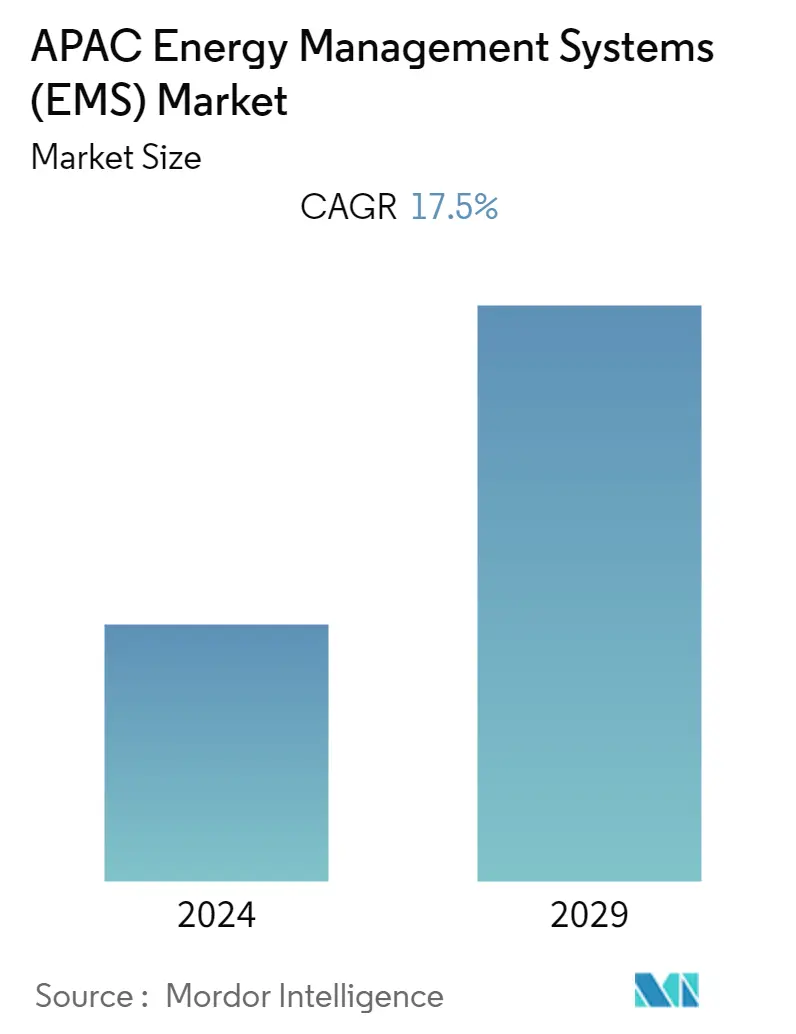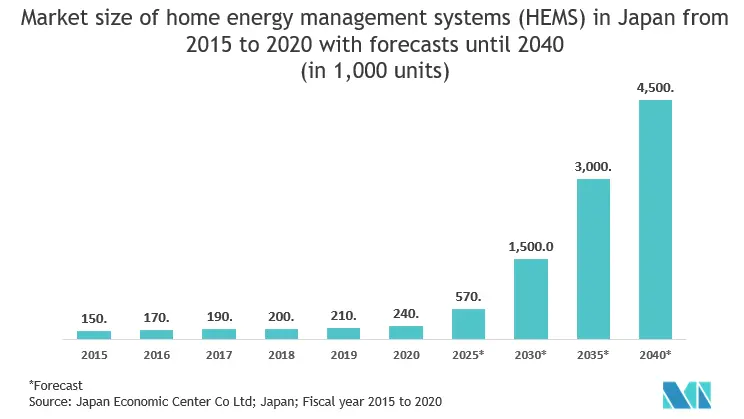APAC Energy Management Systems Market Size

| Study Period | 2019 - 2029 |
| Base Year For Estimation | 2023 |
| Forecast Data Period | 2024 - 2029 |
| Historical Data Period | 2019 - 2022 |
| CAGR | 17.50 % |
| Market Concentration | Medium |
Major Players
*Disclaimer: Major Players sorted in no particular order |
APAC Energy Management Systems Market Analysis
The Asia Pacific Energy Management Systems Market is expected to register a CAGR of 17.5% during the forecast period from 2021 to 2026. Asia-Pacific has been the most rapidly industrializing over the last quarter-century. Energy management requirements and the growing emphasis on reducing utility costs continue to drive the adoption of APAC energy management systems (EMS). The majority of the large buildings in the region are equipped with these systems.
- Proactive measures taken by government organizations in the region for the implementation of standards, such as ISO 50001 (energy-management-system standard) in the building sector, can stimulate the integration of EMS.
- Consequently, more opportunities for automation can now be found across small-to-medium buildings in the region. In the Asia Region, households have grown exponentially over the last two decades. The United Nations expects that urbanization in Asia will reach 64.1% by 2050, further opening up opportunities for the building and construction industry in the region.
- Governments across countries have been actively involved in setting the limits for energy consumption. For instance, structural shifts in the national economy compelled the Government of Vietnam to establish a reduction of energy consumption per unit of GDP ratio as one of the economic targets of the national Sustainable Development Strategy for 2011-2020; as the country remained the most energy-intensive economy in East Asia, behind China, Indonesia, Thailand, Malaysia, and the Philippines.
- NTELS, a Korean tech firm, developed a BEMS where energy data from heating, ventilation, and air conditioning (HVAC) systems were collected. Then, depending on their characteristics, the system identified energy consumption patterns of buildings and created proper energy consumption plans. It also has forecasting and building operations monitoring features, which leads to optimizing energy efficiency in buildings. Such BEMS technology can transform the energy efficiency of the buildings.
- Since the novel coronavirus has been declared a pandemic, most of the businesses and factories are closed or are under severe restrictions. On the other hand, energy consumption in homes, as well as hospitals, has increased drastically. However, the power and energy consumption has decreased overall, mainly due to the halt of manufacturing activity in China, Japan, and India. Nevertheless, relaxation on the restrictions may be apparent in the months ahead. Given the government initiatives to reduce energy consumption, the region will likely provide opportunities over the forecast period.
APAC Energy Management Systems Market Trends
This section covers the major market trends shaping the APAC Energy Management Systems Market according to our research experts:
HEMS (Home EMS) to Experience Significant Growth
- With the rapid improvements in technologies, like network communication, smart grid, bidirectional communication medium's, information infrastructures, energy conservation methodologies, and various techniques, home area networks (HANs) encountered a revolutionary change about multiple areas of power consumption domains, like energy conservation at consumption premises and electricity usage patterns.
- Due to the increasing concern about the efficient use of energy, there is an expanding focus on installing energy-saving devices in households. Energy management systems are cost-effective in all residential buildings, regardless of national energy prices, usage, and climatic factors. Thus they are increasingly being adopted in homes.
- Increasing investment in grid digitization by implementing advanced communications technologies will drive the growth of the residential energy management market. Over the next decade, China is investing USD 6 trillion in infrastructure as part of its urbanization development program. China and the economy, which have signed a cooperation agreement with China on the Belt and Road Initiative (BRI), are rising as a share of the world economy.
- In recent times, there has been a significant surge in the development of connected, intelligent devices, such as smart meters, smart sensors, and smart thermostats that are equipped in smart homes. These devices are experiencing advancements in power monitoring and display technologies.
- For instance, the Government of India planned to create 500 smart cities in a phased manner, with smart homes being the most critical entity of smart cities.

China is Expected to Hold Significant Share
- Over the years, Beijing has pursued an energy intensity target relative to GDP, allowing China to grow at a tremendous pace. However, just like the European Union, China has also put a cap on energy use by 2020. The Government in these regions is proactive in planning for smart meter installation.
- According to the World Green Building Council, China is the largest building construction market globally, with up to 2 billion square meters constructed annually, accounting for nearly half of new construction globally in the coming decade. It is also the world’s largest emitter of greenhouse gas emissions, which allows the country to invest in green buildings using energy management systems.
- Local vendors, especially in China, have AI in their core strategy, and few of them have been successfully raising funds. For instance, R&B Technology Holding, which specializes in creating energy management software for commercial and industrial (C&I) building sectors, led BP Ventures in its latest series of investments, raising USD 3.6 million. R&B’s energy management systems are specifically designed to predict, control, and improve building energy use. This solution supports BP Alternative Energy’s focus on low-carbon power, storage, digital energy value chain, and more comprehensive Energy as a Service (EaaS) offers.

APAC Energy Management Systems Industry Overview
The Asia Pacific Energy Management Systems Market is moderately fragmented with the presence of various international players such as IBM, Honeywell, Schneider Electric, Rockwell Automation, General Electric Company, among others. The companies in the market are launching products with the latest technological developments and are collaborating with various governments and organizations to increase their market share. Some of the recent developments are:
- February 2020 - Honeywell introduced its Forge Energy Optimization systems (a closed-loop, cloud-based machine learning solution) to constantly monitor a building's energy consumption changes to optimal energy-saving settings without affecting occupant comfort levels.
- January 2020 - Schneider Electric unveiled its upgrade to the traditional fusebox to homeowners looking for a better power management system with the company's Energy Center product. The new product is part of a wide range of Square D home energy management devices that the company is aiming at homeowners.
APAC Energy Management Systems Market Leaders
-
IBM Corporation
-
Rockwell Automation Inc.
-
General Electric Company
-
Schneider Electric SE
-
Honeywell International Inc.
*Disclaimer: Major Players sorted in no particular order

APAC Energy Management Systems Market News
- March 2021 - Eaton Corporation debuted its Energy management solution (which combines hardware, software, and services) to demonstrate its' Buildings as a Grid' approach to the energy transition, which aims to help customers increase resilience, accelerate decarbonization, generate new revenue streams, and lower energy costs.
- April 2020 - GE Renewable Energy's Grid Solutions business has been awarded a technology-driven grid modernization project by Rajasthan Rajya Vidyut Prasaran Nigam Limited (RRVPL)(India) of the utility's roadmap to implement grid initiatives and augment renewable energy. GE's Advanced Energy Management Systems will provide real-time data monitoring to understand better current and future energy usage and enable informed, proactive decisions about the transmission of renewable energy.
APAC Energy Management Systems Market Report - Table of Contents
1. INTRODUCTION
- 1.1 Study Assumptions and Market Definition
- 1.2 Scope of the Study
2. RESEARCH METHODOLOGY
3. EXECUTIVE SUMMARY
4. MARKET INSIGHTS
- 4.1 Market Overview
-
4.2 Industry Attractiveness - Porter's Five Forces Analysis
- 4.2.1 Bargaining Power of Suppliers
- 4.2.2 Bargaining Power of Consumers
- 4.2.3 Threat of New Entrants
- 4.2.4 Threat of Substitute Products
- 4.2.5 Intensity of Competitive Rivalry
- 4.3 Industry Value Chain Analysis
5. MARKET DYNAMICS
-
5.1 Market Drivers
- 5.1.1 Increasing Usage Of Smart Grids and Smart Meters
- 5.1.2 Increasing Focus on Green Buildings and Government Initiatives Towards Energy Efficiency
-
5.2 Market Challenges
- 5.2.1 Absence of Technology Alignment and High Acquisition and Implementation Costs
6. MARKET SEGMENTATION
-
6.1 By Type of EMS (Energy Management System)
- 6.1.1 BEMS (Building EMS)
- 6.1.2 IEMS (Industrial EMS)
- 6.1.3 HEMS (Home EMS)
-
6.2 By End-User Industry
- 6.2.1 Manufacturing
- 6.2.2 Power and Energy
- 6.2.3 IT and Telecommunication
- 6.2.4 Healthcare
- 6.2.5 Other End-user Industries
-
6.3 By Component
- 6.3.1 Hardware
- 6.3.2 Software
- 6.3.3 Services
-
6.4 By Country
- 6.4.1 China
- 6.4.2 India
- 6.4.3 Japan
- 6.4.4 South Korea
- 6.4.5 Rest of Asia Pacific
7. COMPETITIVE LANDSCAPE
-
7.1 Company Profiles
- 7.1.1 IBM Corporation
- 7.1.2 Rockwell Automation Inc.
- 7.1.3 General Electric Company
- 7.1.4 Schneider Electric SE
- 7.1.5 Cisco Systems Inc.
- 7.1.6 Uplight Inc.
- 7.1.7 Eaton Corporation
- 7.1.8 Enel X S.r.l.
- 7.1.9 Elster Group SE (Elster Group)
- *List Not Exhaustive
8. INVESTMENT ANALYSIS
9. FUTURE OF THE MARKET
** Subject To AvailablityAPAC Energy Management Systems Industry Segmentation
Energy management systems help monitor and control energy consumption in industries, commercial facilities, and residential sectors. The data collected is presented intuitively, which helps make sound decisions to improve the building's energy performance. This study also covers the impact of COVID19 on the energy management systems market.
| By Type of EMS (Energy Management System) | BEMS (Building EMS) |
| IEMS (Industrial EMS) | |
| HEMS (Home EMS) | |
| By End-User Industry | Manufacturing |
| Power and Energy | |
| IT and Telecommunication | |
| Healthcare | |
| Other End-user Industries | |
| By Component | Hardware |
| Software | |
| Services | |
| By Country | China |
| India | |
| Japan | |
| South Korea | |
| Rest of Asia Pacific |
APAC Energy Management Systems Market Research FAQs
What is the current APAC Energy Management Systems (EMS) Market size?
The APAC Energy Management Systems (EMS) Market is projected to register a CAGR of 17.5% during the forecast period (2024-2029)
Who are the key players in APAC Energy Management Systems (EMS) Market?
IBM Corporation, Rockwell Automation Inc., General Electric Company, Schneider Electric SE and Honeywell International Inc. are the major companies operating in the APAC Energy Management Systems (EMS) Market.
What years does this APAC Energy Management Systems (EMS) Market cover?
The report covers the APAC Energy Management Systems (EMS) Market historical market size for years: 2019, 2020, 2021, 2022 and 2023. The report also forecasts the APAC Energy Management Systems (EMS) Market size for years: 2024, 2025, 2026, 2027, 2028 and 2029.
APAC Energy Management Systems Industry Report
Statistics for the 2024 APAC Energy Management Systems market share, size and revenue growth rate, created by Mordor Intelligence™ Industry Reports. APAC Energy Management Systems analysis includes a market forecast outlook 2029 and historical overview. Get a sample of this industry analysis as a free report PDF download.



